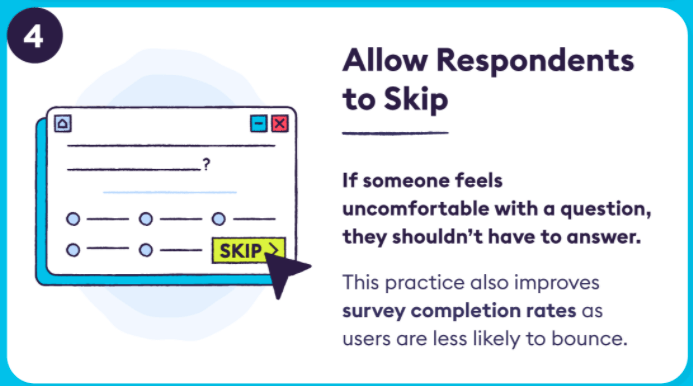In 2021 and beyond, it is essential that when writing demographic survey questions that you be inclusive and culturally aware with how you phrase your questions and what answer choices you provide.
To be inclusive, you must consider how your respondents might feel by working to eradicate your own intrinsic bias. Removing this bias is a difficult task, but necessary when creating external surveys geared towards your target audience, clients, or customers. See the tips below for how to write demographically inclusive survey questions.
1. Have Open-Ended Responses When Applicable
A lot of surveys contain simple yes/no questions because they’re aiming to create a simple binary data point. However, when writing demographic survey questions it is important to have an open-ended response such as “other” or “does not apply.” The open-ended response allows for surveyees to answer truthfully and not feel boxed in. Furthermore, this provides you with more accurate information.
2. Disclose the Use of Data
Many survey respondents are inherently skeptical of surveys because of the notion that their personal information or data will be sold and shared with third-party collectors.
To proactively counteract this thought process, be upfront at the beginning of your survey. Clearly state how you intend to use these respondents’ information and data. Try to answer the following questions at the beginning through a short paragraph or two.
- Who will have access to my data?
- Will you sell my personal information?
- How long will my information be kept on file?
- What is the intended purpose or use of my personal data?
3. Randomize Answers
This might seem obvious, but it is essential to randomize your answers when conducting multiple-choice questions. Randomizing answer choices will do several things. First, it will reduce any bias you had when creating the survey and listing the answer choices. Second, it will make surveyees pay more attention to the question and their answer if they can’t predict which selection to make.
For demographic questions, if you’re discussing race and you consistently put Caucasian or white first, then some might perceive that to be the norm and could take offense. Randomizing the order will help resolve this issue.
4. Utilize Skip Logic
Skip logic is using logic-based rules to have respondents who answer a certain question skip over or move past other non-relevant questions. For example, if your demographic survey asks about being a certain religion such as Hindu then later asks if they celebrate Hanukkah that can be quite offensive. The skip logic and algorithm will take respondents to a different question that is more appropriate and relevant to who they are.
Try to use these tips when creating your next demographic survey for either internal team and employee purposes or externally to better understand your target audience. For more tips on how to write demographically inclusive survey questions visit Chattermill and see their guide below.





